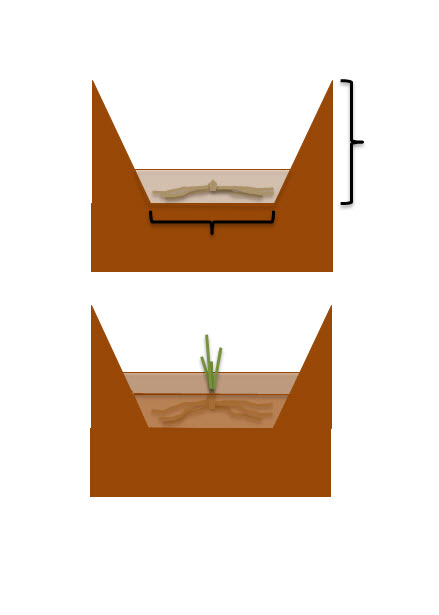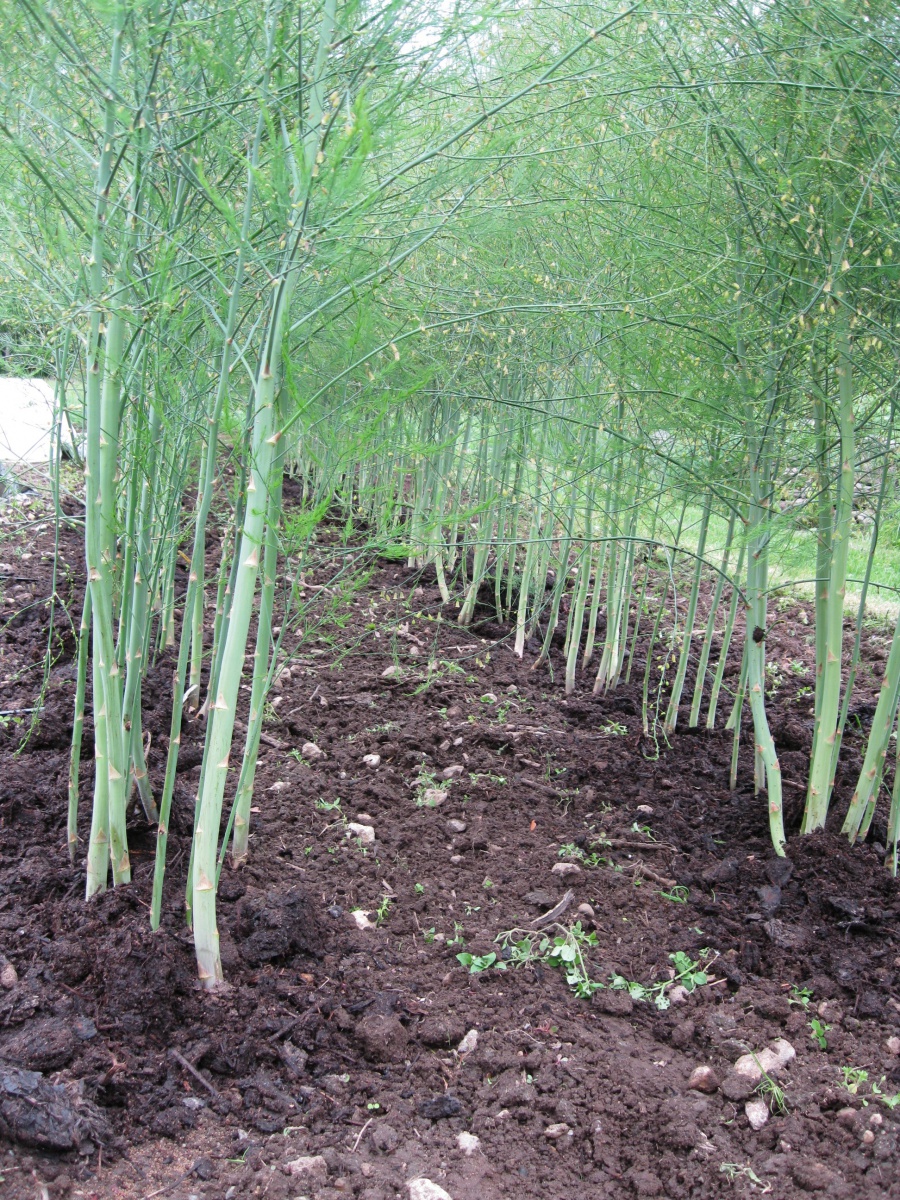Asparagus is a perennial crop that produces spears year after year for 10 to 15 years or longer if the plants are given adequate care. Because it remains in the same location for many years, it’s important to select a planting site that’s convenient, as well as having good growing characteristics in mind. The edge of a garden might be preferable to the middle to accommodate future gardening activities.
Asparagus
Asparagus is grown for its succulent, immature shoots that, if allowed to grow, will eventually become the bushy foliage called ferns. In southern New Hampshire the young spears emerge about the first week in May or when the soil temperature reaches about 40 degrees F. Growth continues into late fall or early winter until the ferns are killed by frost.
Growth Characteristics
The asparagus plant is made up of top (ferns), crown (buds) and roots. All three are vital to a productive plant. The ferns are the “factory,” which, through the process of photosynthesis, produces food stored in the crown and roots below ground. The number of vigorous spears in the spring depends upon the amount of food produced and stored in the crown during the preceding summer and fall. Producing a good crop of ferns is necessary to ensure a good crop of spears the next spring.
Do not cut back the old ferns at the end of the season until they are completely dead. In the fall, nutrients move from the dying ferns to the crown. Removing the ferns too early weakens the crown and may thereby reduce the size and number of spears the following spring.
Growing Conditions
Site - Full sun is ideal. Asparagus needs at least 8 hours of sun per day. Since asparagus is a long-lived perennial, do not plant where trees or tall shrubs might eventually shade the plants or compete for nutrients and water.
Soil - The crown and root system can grow to an enormous size: 5 to 6 feet in diameter and 10 to 15 feet deep. Therefore, where possible, select a soil that is loose, deep, well-drained and fertile. On sites with poor soil, incorporate manure, compost, and/or green manure cover crops into the soil before you plant asparagus.
Fertilizer - Have soil tested before planting and every three years thereafter. Soil testing can be done through a number of private and public labs. UNH Cooperative Extension offers this service. Forms and instructions are available on our website, or you can call our Info Line at 1-877-EXT-GROW (1-877-398-4769).
Adjust the soil pH to 6.5 to 6.8 by adding the appropriate quantity of limestone or wood ashes as recommended by a soil test. Fertilizer requirements are also determined by the same soil test. A general recommendation is to add the equivalent of 2.5 pounds of 10-10-10 fertilizer per 100 square feet. All lime and fertilizer materials should be thoroughly incorporated into the soil to a depth of 10 to 12 inches before planting.
Planting
Asparagus is planted in the spring. The simplest method is to plant one-year-old crowns purchased from local garden dealers or through home garden catalogs. Even though the young crown will appear to be a lifeless mass of stringy roots, it will begin to send up small green shoots (spears) shortly after planting.
Set plants 18 inches apart in rows five feet apart. Dig holes or trenches about 8 inches deep and 10 inches wide. Spread the roots in the bottom of the hole or trench and cover the crown with about 2 inches of soil. As the young shoots continue to grow during the first summer, gradually fill in the hole with soil. The tops of the crowns should be about 6 inches below the soil surface when the trenches are completely filled. This allows for cultivation by hoe or rototiller and also provides a sufficient depth of soil for new buds to develop on top of the crown.
An alternative to using one-year-old crowns is to start asparagus transplants from seeds as you would start other vegetable transplants. About 6 to 8 weeks before planting, sow the seeds directly into pots. Thin to one plant per pot and, after all danger of frost has passed, plant the young seedlings as described above for crowns. Do not cover the young shoots (ferns) with soil.

Weed Control
Weeds are the most common problem in asparagus plantings, because they compete with the crop and reduce productivity.
Do not plant asparagus or any vegetable in an area heavily infested with quackgrass or other weeds that spread by rhizomes. If necessary, begin a year in advance to clean out the quackgrass, either by hand or mechanical cultivation or by spraying with an approved herbicide when the grass is 6 to 8 inches tall. If using herbicides, follow label directions precisely for safety and good weed control. In addition to planting in an area free of weeds, it can be helpful to maintain a tilled border around the asparagus planting, to prevent weeds from outside the patch from migrating into the planting.
To manage annual weeds, mulch with straw, grass clippings, chopped leaves, or pine needles after the trenches have been filled in. Hand-hoeing while weeds are small is also effective.

Pest Control
The asparagus beetle is the most serious insect pest that affects asparagus. The larvae are dark and slug-like and are found on the ferns. There are two types of asparagus beetle; the common asparagus beetle (Crioceris asparigi) and the spotted asparagus beetle (C. duodecimpunctata). The adult spotted asparagus beetle is red with black spots, and the adult common asparagus beetle is metallic-colored with yellow spots. You can also reduce the damage caused by these insects if you practice “clean harvest”, meaning that you harvest all of the spears every time you harvest during the time that you’re harvesting, and then let all of them grow to ferns. At the end of fall, remove all of the dead ferns and crop debris that would otherwise shelter the adult beetles. If these practices do not control the pest, several insecticides are labeled for management of asparagus beetle.
Asparagus rust and Fusarium crown and root rot are common diseases. Both diseases can weaken asparagus plants, so that the planting becomes less productive over time. Most varieties are fairly resistant to rust. Removing old ferns provides additional protection. Fusarium is more difficult to control. Use vigorous varieties listed as tolerant and do not plant new asparagus in areas that were previously planted to asparagus.
Harvest
Do not harvest asparagus until the third year after planting. The plants need at least two full seasons of growth before they build up ample food reserves to sustain harvests. In the third year, harvest only 2 to 3 weeks. In years thereafter, harvest no longer than 6 to 8 weeks (until about July 1 in southern New Hampshire). Harvesting for a longer period of time will not allow for maximum fern growth. Harvest the spears when they are 6 to 8 inches tall. Either snap or cut the spears off at ground level. To avoid injuring spears beneath the soil surface, do not cut more than one inch below the surface.
Storage
Asparagus is of highest quality when freshly harvested. It can be stored for a couple of weeks if the temperature is held at 34 degrees F and high relative humidity, but sweetness and flavor will deteriorate. Maintain short-term freshness by standing an asparagus bunch in about an inch of water in a flat-bottomed container in the refrigerator.
Care of Established Plantings
Remove ferns in the late fall, once they have completely died back. Early each spring, cultivate to remove any perennial weeds, and apply fertilizer materials over the surface. Apply the equivalent of 10-10-10 fertilizer at about 2,5 pounds per 100 square feet. Incorporate very lightly into the soil, no deeper than 1 to 2 inches. If you choose to use compost or animal manures, apply them just after you stop harvesting for the year. Keep the asparagus planting weed free with mulches or by hand-weeding.
Download the Resource for the complete fact sheet and a printable version.